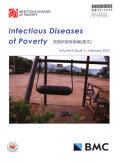- 钛学术文献服务平台 \
- 学术期刊 \
- 医药卫生期刊 \
- 内科学期刊 \
- 贫困所致传染病(英文)期刊 \
null
Molluscicidal effectiveness of Luo-Wei, a novel plant-derived molluscicide, against Oncomelania hupensis, Biomphalaria alexandrina and Bulinus truncatus
基本信息来源于合作网站,原文需代理用户跳转至来源网站获取
摘要:
Background:Control of snail intermediate hosts has been proved to be a fast and efficient approach for interrupting the transmission of schistosomiasis.Some plant extracts have shown obvious molluscicidal activity,and a new compound Luo-Wei,also named tea-seed distilled saponin (TDS),was developed based on the saponins extracted from Camellia oleifera seeds.We aimed to test the molluscicidal activity of 4% TDS against the intermediate host snails in China and Egypt,and evaluate its environmental safety to non-target organisms.Methods:In the laboratory,Oncomelania hupensis,Biomphalaria alexandrina and Bulinus truncatus were exposed to 4% TDS,and the median lethal concentration (LC5o) was estimated at 24,48 and 72 h.In the field,snail mortalities were assessed 1,2,3 and 7 d post-immersion with 2.5 g/m3 4% TDS and 1,3,7 and 15 d post-spraying with 5 g/m2 4% TDS.in addition,the acute toxicity of 4% TDS to Japanese quail (Coturnixjaponica),zebrafish (Brachydanio rerio)and freshwater shrimp (Macrobrachium nipponense) was assessed by estimations of LC5o or median lethal dose (LD5o).Results:In the laboratory,the LC5o values of 4% TDS for O.hupensis were 0.701,0.371 and 0.33 mg/L at 24,48 and 72 h,respectively,and 4% TDS showed a 0.33 mg/L 24 h LC5o against B.alexandrina,and a 1.396 mg/L 24 h LCs0 against B.truncatus.Across all study regions,the pooled mortalities of O.hupensis were 72,86,94 and 98% at 1,2,3 and 7 d,following field immersion of 4% TDS at a dose of 2.5 g/m3,and were 69,77,85 and 88% at 1,3,7 and 15 d,following field spraying at 5 g/m2,respectively.4% TDS had moderate toxicity to Japanese quail (7 d LD5o > 60 mg/kg) and to shrimp (96 h LCs0 =6.28 mg/L;95% CI:3.53-11.2 mg/L),whereas its toxicity to zebrafish was high (96 h LCso--0.15 mg/L;95% CI:0.14-0.17 mg/L).Conclusions:4% TDS is active against O.hupensis,B.alexandrina and B.truncatus under laboratory and field conditions,and it may be a candidate molluscicide of plant origin.

推荐文章
期刊_丙丁烷TDLAS测量系统的吸收峰自动检测
带间级联激光器
调谐半导体激光吸收光谱
雾剂检漏 中红外吸收峰 洛伦兹光谱线型
不同盐度、温度及光照对漂浮浒苔生理生态的影响
浒苔
盐度
温度
光照
生理生态
期刊_联合空间信息的改进低秩稀疏矩阵分解的高光谱异常目标检测
高光谱图像
异常目标检测 低秩稀疏矩阵分解 稀疏矩阵 残差矩阵
内容分析
关键词云
关键词热度
相关文献总数
(/次)
(/年)
文献信息
| 篇名 | Molluscicidal effectiveness of Luo-Wei, a novel plant-derived molluscicide, against Oncomelania hupensis, Biomphalaria alexandrina and Bulinus truncatus | ||
| 来源期刊 | 贫困所致传染病(英文) | 学科 | |
| 关键词 | |||
| 年,卷(期) | 2019,(2) | 所属期刊栏目 | |
| 研究方向 | 页码范围 | 70-79 | |
| 页数 | 10页 | 分类号 | |
| 字数 | 语种 | 英文 | |
| DOI | |||
五维指标
引文网络
引文网络
二级参考文献 (50)
共引文献 (11)
参考文献 (33)
节点文献
引证文献 (0)
同被引文献 (0)
二级引证文献 (0)
1970(1)
- 参考文献(1)
- 二级参考文献(0)
1972(1)
- 参考文献(1)
- 二级参考文献(0)
1982(3)
- 参考文献(2)
- 二级参考文献(1)
1985(1)
- 参考文献(1)
- 二级参考文献(0)
1988(1)
- 参考文献(1)
- 二级参考文献(0)
1991(1)
- 参考文献(1)
- 二级参考文献(0)
1992(1)
- 参考文献(0)
- 二级参考文献(1)
1994(2)
- 参考文献(0)
- 二级参考文献(2)
1995(3)
- 参考文献(0)
- 二级参考文献(3)
1996(2)
- 参考文献(1)
- 二级参考文献(1)
1997(1)
- 参考文献(0)
- 二级参考文献(1)
1998(2)
- 参考文献(0)
- 二级参考文献(2)
2000(3)
- 参考文献(1)
- 二级参考文献(2)
2001(2)
- 参考文献(0)
- 二级参考文献(2)
2002(3)
- 参考文献(0)
- 二级参考文献(3)
2003(2)
- 参考文献(0)
- 二级参考文献(2)
2004(1)
- 参考文献(0)
- 二级参考文献(1)
2005(4)
- 参考文献(0)
- 二级参考文献(4)
2006(4)
- 参考文献(1)
- 二级参考文献(3)
2007(6)
- 参考文献(1)
- 二级参考文献(5)
2008(4)
- 参考文献(1)
- 二级参考文献(3)
2009(7)
- 参考文献(2)
- 二级参考文献(5)
2010(5)
- 参考文献(3)
- 二级参考文献(2)
2011(8)
- 参考文献(1)
- 二级参考文献(7)
2012(1)
- 参考文献(1)
- 二级参考文献(0)
2013(2)
- 参考文献(2)
- 二级参考文献(0)
2014(3)
- 参考文献(3)
- 二级参考文献(0)
2015(4)
- 参考文献(4)
- 二级参考文献(0)
2016(2)
- 参考文献(2)
- 二级参考文献(0)
2017(1)
- 参考文献(1)
- 二级参考文献(0)
2018(2)
- 参考文献(2)
- 二级参考文献(0)
2019(0)
- 参考文献(0)
- 二级参考文献(0)
- 引证文献(0)
- 二级引证文献(0)
引文网络交叉学科
相关学者/机构
期刊影响力
贫困所致传染病(英文)
主办单位:
中华医学会
出版周期:
双月刊
ISSN:
2095-5162
CN:
10-1399/R
开本:
出版地:
上海市黄浦区瑞金二路207号
邮发代号:
创刊时间:
2016
语种:
eng
出版文献量(篇)
434
总下载数(次)
0
期刊文献
相关文献
推荐文献

 免费查重
免费查重










